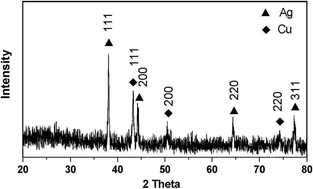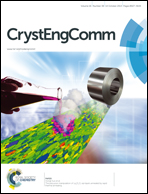One-pot synthesis of Ag@Cu yolk–shell nanostructures and their application as non-enzymatic glucose biosensors†
Abstract
In this report, Ag@Cu yolk–shell nanostructures have been synthesized through a facile one-pot hydrothermal method. The synthesis is based on the use of N,N-dimethylformamide (DMF) as both the reducing agent and solvent, in the presence of the polymer poly(vinylpyrrolidone) (PVP). The structure and composition of the yolk–shell nanostructures were characterized by X-ray diffraction (XRD), scanning electron microscopy (SEM), transmission electron microscopy (TEM), and energy dispersive spectrometry (EDS). To study the formation process of the Ag@Cu yolk–shell nanostructures, the samples obtained at various stages of the growth process were studied by TEM and XRD, and a rational growth mechanism for the Ag@Cu yolk–shell nanostructures was proposed. The as-prepared Ag@Cu yolk–shell nanostructures were used to construct non-enzymatic glucose sensors. The detecting results show that the designed sensors have well-defined, stable and fast amperometric responses to glucose.


 Please wait while we load your content...
Please wait while we load your content...